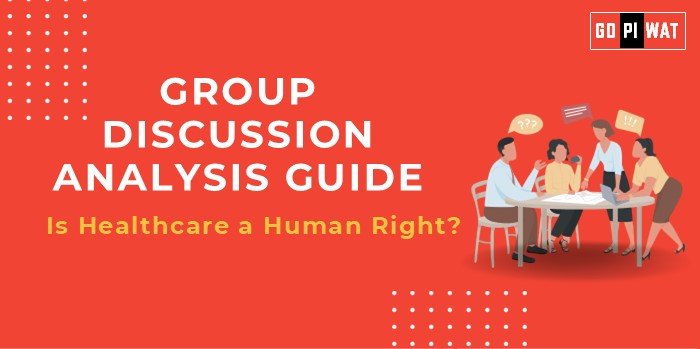📋 Group Discussion (GD) Analysis Guide: Is Healthcare a Human Right?
🌐 Introduction to the Topic
Context Setting: “Access to healthcare directly impacts societal well-being and economic stability, yet disparities in availability spark global debates on whether it should be a fundamental right.”
Background: The notion of healthcare as a human right dates back to the Universal Declaration of Human Rights (1948). Countries like the UK and Canada have universal healthcare systems, while others, including the US, rely heavily on privatized models. The discussion remains relevant in addressing inequalities, especially post-COVID-19.
📊 Quick Facts and Key Statistics
- 🌍 Global Health Coverage Gap: Over 50% of the world lacks access to essential healthcare services (WHO, 2023).
- 💸 Health Inequality: Low-income countries spend less than $50 per capita on health, compared to $5,000+ in high-income countries (World Bank, 2022).
- 🇮🇳 India’s Healthcare Allocation: Only 2.1% of GDP (2022), below the global average of 5.9% (OECD).
- 🇺🇸 US Healthcare Costs: Over 30% of citizens report skipping medical care due to costs (CDC, 2022).
👥 Stakeholders and Their Roles
- 🏛️ Governments: Responsible for policy creation, public health funding, and ensuring equitable access.
- 🩺 Healthcare Providers: Deliver essential services, often grappling with resource limitations.
- 👥 Citizens: Drive demand and advocate for universal coverage.
- 🌍 NGOs/International Bodies: WHO and similar organizations promote global health initiatives and fund critical programs.
🏆 Achievements and Challenges
Achievements:
- ✨ Global Examples: UK’s NHS offers free healthcare to residents.
- 🇮🇳 India: The Ayushman Bharat scheme covers 500 million underprivileged citizens.
- 📡 Technology: Telemedicine expanded healthcare access during COVID-19.
Challenges:
- ⚠️ Accessibility: Rural-urban divide in healthcare infrastructure.
- 💰 Affordability: Out-of-pocket expenses remain high in low-income regions.
- 🌏 Global Comparisons: Despite the US spending 17% of GDP on healthcare, significant inequities persist.
📚 Structured Arguments for Discussion
- ✅ Supporting Stance: “Healthcare is a fundamental right that ensures societal equity and economic productivity.”
- ❌ Opposing Stance: “Recognizing healthcare as a right could strain public finances, compromising service quality.”
- ⚖️ Balanced Perspective: “While healthcare should be universally accessible, balanced funding models are crucial for sustainability.”
🎯 Effective Discussion Approaches
- 💡 Opening Techniques:
- Use impactful statistics: “Over 50% of the global population lacks basic healthcare…”
- Highlight contrasts: “While healthcare is free in the UK, US citizens face exorbitant medical bills.”
- 🛠️ Counter-Argument Handling:
- Cite real-world examples: “Thailand’s universal coverage model successfully reduced inequality without bankrupting the system.”
🔍 Strategic Analysis of Strengths and Weaknesses
Strengths:
- 📈 Improves quality of life.
- 💼 Increases productivity.
- 🌍 Enhances global standing.
Weaknesses:
- 💸 Funding constraints.
- 🏢 Bureaucratic inefficiencies.
- ⚖️ Potential overuse of services.
Opportunities:
- 🤖 Leverage AI in diagnostics.
- 🤝 Public-private partnerships for affordability.
Threats:
- 📉 Rising costs.
- 🏥 Resistance from private stakeholders.
🎓 Connecting with B-School Applications
- 🌟 Real-World Applications: Analyze healthcare reforms, assess the financial impact of universal health systems.
- ❓ Sample Interview Questions:
- “How can public-private partnerships improve healthcare delivery?”
- “What are the economic implications of recognizing healthcare as a human right?”
- 📘 Insights for Students: Explore healthcare’s role in sustainable development and social entrepreneurship.


